A Year's Hard Labor: The Leading Index for Indiana
 In October 2009, the Indiana Business Research Center (IBRC) launched the Leading Index for Indiana (LII), an economic indicator designed to predict changes in the general direction of Indiana’s economic activity. At the time of its initial release, the LII was shown to lead movement in the Philadelphia Federal Reserve’s coincident index of economic activity in Indiana by several months. Specifically, the LII peaked and began to fall at least six months prior to changes in economic activity. Figure 1 shows the index’s movement since June 1997.
In October 2009, the Indiana Business Research Center (IBRC) launched the Leading Index for Indiana (LII), an economic indicator designed to predict changes in the general direction of Indiana’s economic activity. At the time of its initial release, the LII was shown to lead movement in the Philadelphia Federal Reserve’s coincident index of economic activity in Indiana by several months. Specifically, the LII peaked and began to fall at least six months prior to changes in economic activity. Figure 1 shows the index’s movement since June 1997.
Figure 1: The Leading Index for Indiana, June 1997 to August 2010
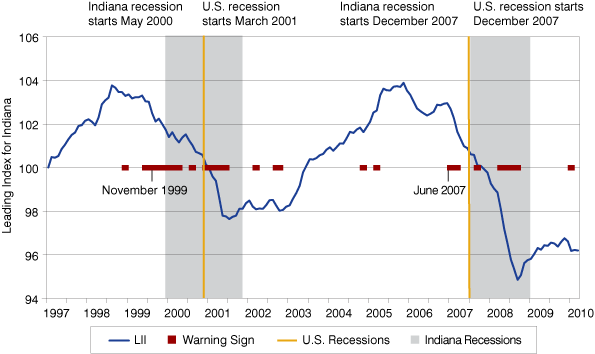
Note: Hash marks indicate June and December of each year except 2010.
Source:
Indiana Business Research Center
The LII contains five components that, in contrast to the Conference Board’s leading index for the national economy, reflect the structure of the Indiana economy. The five components are the National Association of Home Builders’ Housing Market Index (HMI); the Census Bureau’s value of unfilled motor vehicles and parts orders; the interest rate spread between the Fed Funds rate and the 10-year Treasury yield; the Purchasing Managers Index (PMI); and the Dow Jones Transportation Average. While these are all national measures, they become available more quickly than do state-level data. As a result, they offer a more timely view of what the future might hold.
In the year since its initial release, the LII has increased, albeit at an anemic pace, signaling that the Indiana economy is in the midst of a tepid recovery from the last recession. The LII’s movement is consistent with movement in the Conference Board’s leading economic indicator for the United States as a whole, as well as with the Philadelphia Federal Reserve’s coincident index for Indiana. The LII showed the “green shoots” of an economic recovery in March 2009. The National Bureau of Economic Research (the committee of economists that determine when recessions start and end) reported that the national recession ended in June 2009. Indiana’s recession ended one month later based upon the Philadelphia Fed’s coincident index for Indiana, which bottomed out in July 2009. The LII, therefore, did a solid job of predicting the turn of the economy four months before the U.S. recession ended and five months before the Indiana recession ended.
To see how well the LII has predicted Indiana’s economic activity, we can look at a lagged match-up of the LII and the Philadelphia Fed’s index. Figure 2 shows the LII six months ahead, juxtaposed with the Philadelphia Fed coincident index for Indiana. The patterns are very similar. The downturn is predicted at the right time, as is the recovery. Note that the lagged LII peaks in October of this year, with the drop sustained between November and January. In a few months we may see yet another test of the LII’s validity as a prediction tool.
Figure 2: Indiana Coincident Index and Six-Month Advance LII, July 2007 to January 2011
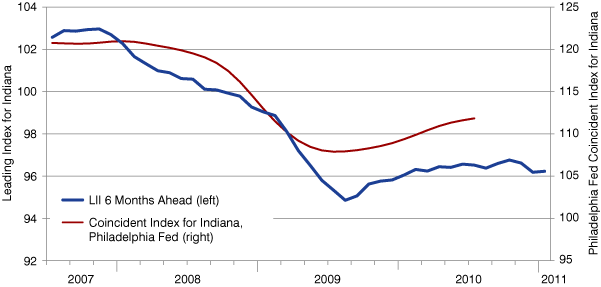
Note: Hash marks indicate every other month.
Source:
Indiana Business Research Center
Past movement in the LII has shown it to be a reliable predictor of changes in Indiana’s economic activity. The LII is only one measure, however, and is best used in conjunction with other indexes that portend changes in the economy, such as the Ceridian-UCLA Pulse of Commerce Index 1 and the Architectural Billings Index.2
Given the LII’s predictive validity, the past few months have produced some troubling signs. From July 2009 through April 2010, the LII increased from 96.0 to 96.8; not break-neck growth, but still movement in a positive direction. This movement was also consistent with the Philadelphia Federal Reserve’s coincident indicator of economic activity in the state over the same time period. In May, the LII dropped, and it prompted a warning sign when it dropped again in June (as shown in Figure 1). Warning signs occur when three of the five components of the LII decline and the LII declines overall. The LII has remained virtually unchanged since June at a value of 96.2. This level is only marginally higher than the level of the LII when the IBRC began releasing it last year.
In contrast to the LII’s summer decline, the Philadelphia Fed’s coincident index for Indiana has risen consistently over the last year, although its rate of increase has fallen since about February. Figure 3 compares the movement of the two indices since last July. The coincident index is a measure of Indiana’s economic activity in real time. Therefore, the drop and subsequent stagnation of the LII do not bode well for future growth in Indiana, especially given that the coincident index’s growth has slowed.
Figure 3: LII and Coincident Index for Indiana, July 2009 to August 2010
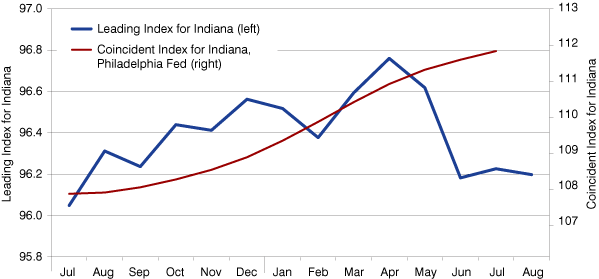
Source: Indiana Business Research Center
As Figure 4 shows, the LII peaked at least a year before the Philadelphia Fed’s coincident index for each of the last two recessions. With any luck, the April LII level of 96.8 constitutes a slight surge along a longer-term growth path rather than an overall peak (that would signal a negative turn in the economy), given that the LII has been essentially flat for the last several months.
Figure 4: Index of LII and Coincident Index for Indiana, June 1997 to June 2010
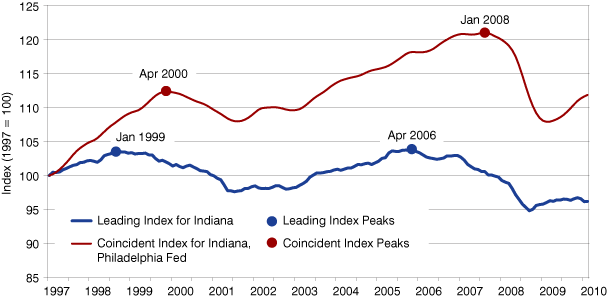
Note: Hash marks indicate June and December of each year except 2010.
Source:
Indiana Business Research Center
The Conference Board’s leading index for the United States is showing a trend similar to the LII. This index could be a valuable benchmark for the LII, since it also predicts the change in direction of economic activity at the national level.3 From July 2009 through April 2010, the Conference Board’s leading index has increased along with the LII, as shown in Figure 5. Since April, however, it has essentially leveled off. It will be useful to watch this index over the next several months to see if this constitutes a change in momentum or if it is simply a temporary stall.
Figure 5: LII and Conference Board U.S. Leading Index, July 2009 to August 2010
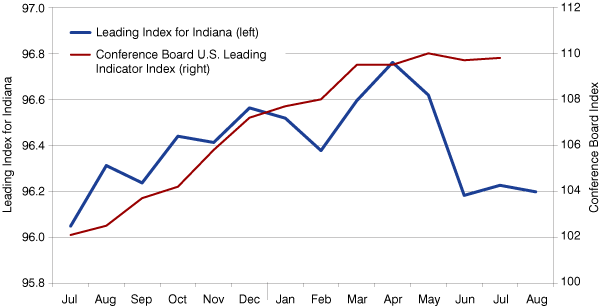
Source: Indiana Business Research Center
The LII has been stagnant for three months, raising concerns about the fragility of Indiana’s recovery. It should also make the coming months interesting, both in terms of discovering if Indiana’s economy follows the LII’s trend and in terms of predicting which direction the economy will take next year.
Notes
- The Ceridian-UCLA Pulse of Commerce Index (PCI) is based on real-time fuel consumption data for over-the-road trucking. By tracking the volume and location of diesel fuel being purchased, the index closely monitors the over-the-road movement of raw materials, goods-in-process and finished goods to U.S. factories, retailers and consumers. For more information, visit ycharts.com/indicators/ceridian_ucla_pulse_of_commerce_index.
- The Architecture Billings Index (ABI) is a diffusion index derived from the monthly Work-on-the-Boards survey, conducted by the Economics & Market Research Group of the American Institute of Architects. The ABI serves as a leading economic indicator that leads nonresidential construction activity by approximately nine to 12 months. For more information, visit www.aia.org/practicing/economics/AIAS076265.
- The Conference Board Leading Economic Index has 10 components that are weighted from 0.3248 (the greatest) for the money supply (M2) to 0.0192 (the least) for Manufacturers' new orders, nondefense capital goods. The LII, in contrast, weighs each of its five components equally. For more information, visit www.conference-board.org/pdf_free/economics/bci/hereagain.pdf.
Ryan Krause
Research Assistant, Indiana Business Research Center, Indiana University Kelley School of Business
Timothy Slaper
Director of Economic Analysis, Indiana Business Research Center, Indiana University Kelley School of Business
